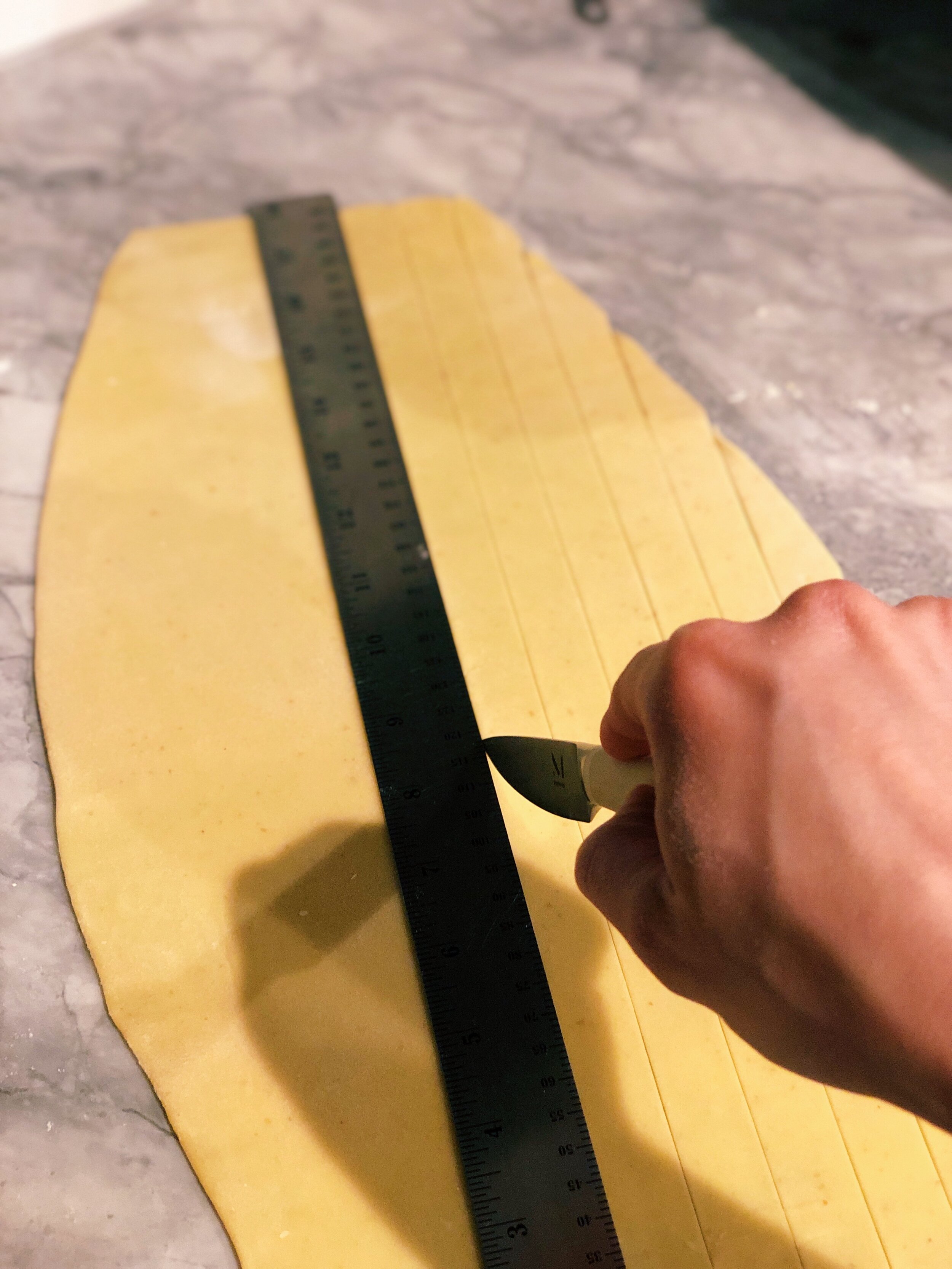Bolognese with Sourdough Pasta
It’s going to be awhile before most of us can travel again, so humor me for a second. Imagine you’re in Bologna on a chilly spring afternoon. The bells of San Petronio echo through the rain-slick Piazza Maggiore, rust-colored colonnades—normally abuzz with students—stand hollow, the town is quiet but for a few beleaguered workers rushing home, shoulders hunched against the wind. From a nearby window wafts the fragrance of herbs and simmering fat, heady and familiar. You feel anchored and transported all at once.
When Amazon mixed up my request for ground turkey with ground beef, I suddenly wanted bolognese. Badly. Traditional bolognese (the way nonna would make it) is a rich, silky meat sauce. It should not be drowning in tomatoes or tarted up with basil, a five-meat medley, or, god help us, fish sauce. The key ingredient here is time.
And of course, you could boil up some Barilla and call it a day, but since we’re going to be here for awhile, why not make your own sourdough pasta? Wild yeast and lactobacilli help neutralize the phytic acid in wheat (phytates inhibit the breakdown of starches and proteins in the stomach, which causes digestive issues), so adding sourdough starter actually makes foods like pasta easier to digest. Need any more reasons to make this? Thought not!
A quick tip on how to finish pasta: Don’t dump out your pasta water right away! Adding about 1/3 cup of this salty, starchy water to the bolognese right before adding the noodles will help the sauce bind to the pasta, giving it that incredible glossiness that you get in restaurants.
Bolognese with Fresh Sourdough Pasta
Pasta recipe from Sarah Owens’ Heirloom
2 tbsp olive oil
1 onion
3 carrots
3 ribs of celery
3 cloves of garlic
Olive oil
Salt and pepper
2 pounds ground beef
2 small cans of tomato paste
2 cups red wine (I like to use a Barbera or Rosso di Montalcino)
3/4 cup milk
3 bay leaves
4-5 full sprigs of thyme
1/2 tsp crushed red pepper flakes
~4 cups beef stock (or chicken stock, or even water)
1/2 cup heavy cream
Grated parmesan (garnish)
Heat a few tablespoons of olive oil and sauté the vegetables over medium-high heat, season with salt and pepper. I like to let the vegetables sweat and brown instead of stirring them too much. Don’t be afraid to let them get a bit burnt—it’ll only make the flavor richer (this will take about 20 minutes).
Brown the beef in a separate pan over medium heat. Season liberally with salt and pepper. Don’t let this overcook. Crispy ground beef is flavorful but to achieve a silky ragu, you just make sure it’s just browned. Pour this and all its juices into the pot with the vegetables and continue to cook for about 10 minutes.
Add tomato paste and let this caramelize for a minute. Deglaze your pot with red wine, add milk, bay leaves, chili flakes, thyme (don’t take the leaves off the stem, just throw the whole sprig in; you can extract them later). Add stock until the meat and veggies are submerged. Bring to a boil, then lower to a simmer. Leave uncovered.
Pour yourself a glass of wine and for the next 3-5 hours, keep an eye on the sauce, stir it once in awhile, add a cup or two of water if it gets too dry, scrape up the bottom occasionally. Toward the end of the third hour, add the cream, and keep simmering. Bolognese can be made in advance and it always tastes better the next day!
Sourdough Pasta
1 3/4 cups whole wheat flour
1/2 tsp fine sea salt
3 large egg yolks, separated
2 tbsp olive oil
1 tbsp sourdough starter discard
4-5 tbsp water, more if needed
4-5 tbsp semolina for dusting
Whisk the dry ingredients together in a medium bowl. In a separate bowl, whisk the egg yolks, olive oil, starter, and 3 tbsp of water.
Make a well (a depression) in the center of your flour mixture and pour the wet ingredients in, mixing gradually with either a fork or your hand until the dough starts coming together. Add remaining 1-2 tbsp water (more if you notice it’s hard to mix). Dough should be stiff but fully hydrated and not crumbly.
On a clean work surface, knead for a few minutes until the dough feels smooth. Wrap in plastic wrap and refrigerate for about an hour to let the gluten relax.
Remove the dough, flour your surface generously, and roll out the dough. If you have a pasta maker, run the dough through the smooth rollers to your desired thickness, then run it through the cutting side. You can also roll and cut the noodles by hand, but this obviously takes a little more effort! Toss with semolina flour to prevent noodles from sticking.
Bring a large pot of heavily salted water to boil (don’t just toss a pinch of salt in there!) and add the noodles, cooking for 45 seconds to a minute (these will cook very quickly, exact timing depends on how thick you make them). Tip: To boil and extract the noodles very gently, you can lower them into the water inside a fine mesh sieve and just hold it there under the water.
Finish the noodles by tossing gently inside the pot of bolognese. Add a little bit of the starchy water to make the sauce bind nicely to the noodles! Serve with a generous heap of shaved parmesan.
PROTECT Frontline Workers and help a Small Business
One of my favorite local designers, the wonderful Christine Alcalay, is making and donating masks for frontline workers! To help her offset the cost of materials and labor, you can donate and also purchase her masks. It’s an added bonus that they come in the loveliest prints with the beautiful craftsmanship I always associate with Christine’s work.




